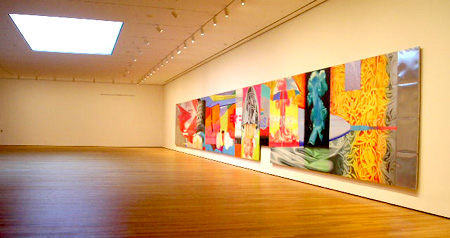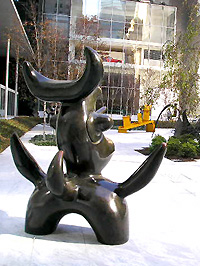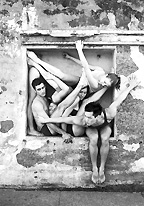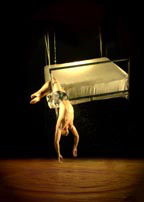A Seismic Change in Audiences Since 9/11
City Opera was founded in 1943 by Mayor Fiorello La Guardia. The City Center on West 55th Street provided a cultural opportunity to a flow of immigrants fleeing Europe. Ticket prices were an issue for them, so accessibility was part of the mission, to the extent of La Guardia calling us the people's opera. That part of the mission survives in our current pricing, low price, $12, high price, $100.

But the mission has also evolved. This year, American artists drive 90 percent of our roster. New works, especially American, are an important part of our repertoire, from unfamiliar pieces from all periods and familiar works seen in a new way. We see our job as keeping opera fresh and growing with our times, a living art, not a museum object.
City Opera is now the country's second largest opera company in activity. This season we are presenting 15 operas in 117 performances. But we are the fifth largest in budget size, so we have to do things efficiently. Our budget by the way is not $35 million. Now what does this require?
To begin with, opera is the most complex performing art, merging music, drama, dance, and design in one enormous, sublime, and expensive experience. We have 144 principal singers on this year's roster, 118 chorus members, and 69 members of the orchestra. There are 73 full-time administrative employees in marketing, fundraising, administration and production. Some 593 part-time employees work for us, and many more work as ushers, porters and stagehands. In all, we need over 15 unions.
Last year, 237,000 people attended, with 82 percent from New York City and the surrounding suburbs. Forty percent were subscribers. But here we begin to get into the problem. These figures are down by about 6 percent from the year 2000.
Since September 11, 2001, there seems to have been a seismic change in audience patterns. Subscriptions are down across the country, even the world. Single ticket buyers are not buying ahead and they are attending fewer performances a year. Sales are off for the tried and true repertory - La Boheme, Carmen and Madame Butterfly -- but often up for the untried and unknown, that for instance when Elizabeth Futral played Daphne by Richard Strauss, which had never been done in New York City, it sold more tickets this fall than any of our other performances.
 The problem seems to be across the board in the performing arts with very few exceptions. It's partly the economy, it's partly a psychological change I suspect, anxiety brought about by the world situation, possibly a hedonistic response that builds restaurants but keeps people away from a two-and-a-half or three-hour challenging experience.
The problem seems to be across the board in the performing arts with very few exceptions. It's partly the economy, it's partly a psychological change I suspect, anxiety brought about by the world situation, possibly a hedonistic response that builds restaurants but keeps people away from a two-and-a-half or three-hour challenging experience.
It's too complex to understand. But the important thing is that we are looking for causes and how to respond in marketing and programming. As examples of how people are facing this, the National Theater in London now has an extended season of 10-pound seats underwritten with corporate support. City Center, returning to the tradition of accessibility, recently ran a highly successful short season of $10 tickets for dance, underwritten by the Peter J. Sharpe Foundation. Covent Garden has done a modified version of the same thing. These houses are all filled.
Now what is the future for City Opera? Most significantly for us will be the realization of our full potential in the new house. We want a smaller hall, with acoustics more suited to our needs, more backstage and rehearsal space, enabling co productions and rental income as well as artistic benefits. City Opera has less than half the backstage space of most theater institutions across the country. And we want a more advantageous performance schedule to increase income potential. We now must open far too early in the season and cannot perform during the big holiday weeks.
As you know there have been many rumors. The New York Times recently reported prominently on one possibility - that's the American Red Cross site on Amsterdam Avenue. But the story was premature to say the very least. It's an idea without a deal, and we are in process of discussions with the American Red Cross site as we continue to be in discussions with other people as well.
But I do assure you of this: Our board and staff are profoundly committed to building a theater in our time at City Opera, and we have been astounded at the support we have been getting after a couple of rather well-publicized disappointments.
There is more promising news. Individual contributed support grew in every category last season. We saw the numbers of members, patrons, and major donors increase by more than 10 percent over previous years. And our board has grown remarkably stronger in recent years, attracting donors at a high level to see our future plans as not only attractive but possible.
The art form itself is in wonderful shape, and so is the artistic life of City Opera. There is no shortage of gifted composers whose work will move and enchant generations to come. There is no shortage of gifted singers who perform for us. In fact, there are more well-trained and exciting young singers converging on the stage than any time in my memory. And our orchestra and chorus have been radically improved in recent years by our music director George Manahan, so that now they are recognized as among the best in the country.

Last year, we had consistently best reviews we have ever had. Next May, City Opera will take 185 people on a tour to Japan as the official U.S. cultural representative for Expo 2005, with the significant sponsorship of the Toyota Corporation, Citigroup Private Banking, and Fuji TV.
Therefore morale at the company is at a very high level. Certainly there are challenges in this perplexing economic and psychological and political climate. We are helped by the fact that we are in a city whose leaders from La Guardia onward have recognized the enormous importance of the arts to its economic, emotional and intellectual well-being, and a city that always seems to recognize the importance of challenge and progress.
Our company's early history in World War II and in times since teaches us that in horrible meonts there is hunger for the enlightenment, distraction, solace, entertainment, joy, and revelation that only art can bring. These are human needs, and I am betting they always will be. Our job is to provide these things and for the future engage new audiences in these feelings with a company that's stable and thriving. I think we can do that.
Paul Kellogg has been general director and artistic director of New York City Opera since 1996
Related Stories:
• Barry Grove: The Manhattan Theater Club Revamps a Legendary Theater
• Paul Kellogg: Seeking a New Space for the New York City Opera
• Glenn Lowry: The Museum of Modern Arts' New Home
• Linda Shelton: Creating a Center for Dance in Lower Manhattan
Nothing Matters More than the Collection
 The new Museum of Modern Art is nearly double the size of the old one, and cost $425 million to construct. |
The Museum of Modern Art was founded in 1929 by three remarkable women including Abby Aldrich Rockefeller. They had what was then and still is a very simple and a very compelling idea, which is that modern art is the art of our time and is every bit as compelling and interesting as the art of the past. And that New York City because it is the city of the future - and certainly was seen as a city of the future in 1929 --should be the premiere place in the world to see, enjoy, and learn about modern art.
That idea has propelled the institution forward from rented space on Fifth Avenue -- 4,000 square feet in the Heckscher Building, now the Crown Building - to our new home that we opened to the public on November 20. The project, designed by Yoshio Taniguchi, was really the result of over a year of reflection and discussion within the institution. We called it "Imagining the Future," when we and the staff and trustees asked ourselves and our friends what it was that we needed to succeed in the 21st century as well as we had in the 20th century. It became very clear that what we needed first and foremost was an architectural platform that would allow the ideas of the institution to be expressed in a new and different way. We needed more space for contemporary art, a completely different layout of the galleries that was more complex, nuanced, and the conversion of the building as an entity from a kind of hermeneutic box that turns inward away from the city into a pulsing center of activity that opened out onto the city.
In 1939, when our first building was created specifically for the museum by architects Philip Goodwin and Edward Stone, we were the first urban museum that opened directly onto the street, that captured the beat, the energy, the pulse of this extraordinary city, and we wanted to regain that, something that had been lost over the intervening decades.

The new, cavernous sixth floor offers temporary exhibitions. Here, "F-111" by James Rosenquist.
So under the remarkable chairmanship of David Rockefeller in our capital campaign, we set out to literally remake the Museum of Modern Art. It involved first of all what we thought would be a capital campaign of $300 million, and I have to confess that the head of development and I looked at $300 million and said, "How could that possibly be? There’s no way."
But by the time we convened a group of remarkable people to work with us on this project, and Yoshio’s plans crystallized, and we realized what the scope of we were going to do would involve, we had a capital campaign of $858 million. The core group of "founders" -- individuals that we had attracted to this project to be part of the remaking of the Museum of Modern Art and that now numbers 55 -- each have given in excess of $5 million. We currently have $725 million raised or pledged.
|
The Abby Aldrich Rockefeller Sculpture Garden has been expanded and features 31 works from the collection. |
What is the project? The project is a $425 million rebuilding of the museum here in Manhattan, $120 million to enable our endowment to sustain operations, and $100 million for future real estate acquisitions. We bought a great deal of land around the museum and in Queens in order to ensure that the next generation of the museum has the space in which to continue. We put $50 million into a kind of a rainy-day fund to help our operation when we were under construction, then we built MoMA QNS, a study and storage center in Long Island City, which we used for a little over two years for temporary exhibitions while we were under construction in Manhattan.
None of this -- absolutely none of this -- would have been possible without catalytic support of the city and then the state. Then-Mayor Rudy Giuliani gave us a $65 million grant that the current administration has ardently supported. Without that seed funding, we could never have launched a capital campaign on this scale. The city was joined by the state, which has now given us $10 million from the governor’s office. That vote of confidence is what allowed us to go out to the private sector and say, "Look, if the city and state have walked into this project at this scale, we really hope that you will match that and exceed it."
Our original hope had been that we could match the city money ten to one. We have far outdone that. By the time this project is through, it will be more like twelve and a half to one.
|
The fifth floor features selections from the museum's sculptures and paintings collection. On the outside wall, "Rhythm of a Russian Dance" by Theo Van Doesburg (1918); in the distant gallery, "Head of A Woman" by Pablo Picasso (1932) |
What I think is critical to understanding why this project has at least made it to where it is is that the museum has always understood a very simple formula, which was that to be an outstanding museum meant having an outstanding collection. Nothing mattered more to the Museum of Modern Art than a singularly important collection.
In order to have a singularly important collection, two factors have to be at play simultaneously and always. The first is an extraordinary board of trustees utterly dedicated and committed to the museum’s mission. The second is an outstanding staff capable of doing the research and creating the support mechanisms and the educational programs to enable the development of an extraordinary collection and ultimately its display to the public.
While I think one can make very strong economic benefit arguments for why the museum’s expansion is beneficial to the city and the state -- and we made those arguments and were very gratified by the city and state’s recognition of the inherent value that cultural institutions play in the vibrancy of New York City and state -- ultimately, the reason we can make those economic arguments is precisely because of the singular importance of the institution as an artistic venue. By that relentless commitment that now extends over three or four generations striving to build an outstanding collection and developing innovative ways of displaying it, the institution has garnered both a considerable public -- approximately 1.8 million people before we began shutting down for the construction project -- and a considerable critical public. That creates a kind of magnetic effect that enables us to look to the future with some degree of confidence.
|
A model of the new Museum of Modern Art as part of an exhibition in the new Museum of Modern Art on nine museums designed by architect Yoshio Taniguchi. |
In a post-9/11 environment I think it is impossible to predict precisely what kind of attendance the museum is likely to generate. Certainly I think it would be foolhardy to assume one can continue on the same path at least on the short term that propelled so many cultural institutions pre-2001 toward a sense of continual growth. We were seeing our audiences grow at five or ten percent every year for seven or eight years in a row. But I do think that this city supports the arts like no other city in America. I do think that the aggregation of cultural institutions in the city makes New York a unique place. And it is the synergy between our institutions that enables us collectively to be bold and adventuresome about the kinds of projects we undertake.
In our case as we open to the public and look to the end of our capital campaign, we are already thinking about the next moves. For us, the construction of this building was not an end but a beginning.
It is now the platform for us to work through the next set of ideas about the Museum of Modern Art as an institution that we would like to think of as isotopic with a series of half lives constantly evolving, constantly changing. What you will see in the new museum is a proposition, an idea about to how perceive and enjoy and appreciate modern art that will change continually. As it changes, so too will the building and so too will our needs. If we have done our job well, we will continue to be a very young institution despite our 75 years.
Glenn Lowry has been the director of the Museum of Modern Art since 1995.
Related Stories:
• Barry Grove: The Manhattan Theater Club Revamps a Legendary Theater
• Paul Kellogg: Seeking a New Space for the New York City Opera
•
Glenn Lowry: The Museum of Modern Arts' New Home
• Linda Shelton: Creating a Center for Dance in Lower Manhattan
Dance Reflects Our Common Humanity
 Joyce Soho, in an old firehouse at 155 Mercer Street, began in 1996, 14 years after the original Joyce Theater in Chelsea Photo by Sava B. Martin |
Most New Yorkers identify the Joyce Theater as their favorite place to see dance. It is a comfortable and intimate space, the sightlines are ideal, and the programming is varied and compelling. And we are almost never dark!
After more than two decades of bringing outstanding national and international dance companies to our audiences, we are on the brink of a major and tremendously exciting expansion. The story of how we got here is not long, but it is long-standing.
Before The Joyce existed, dance companies struggled to find suitable venues where they could hold their New York seasons. I think most people know that Eliot Feld and Cora Cahan with the help of a handful of key supporters renovated the old Elgin movie house and launched the Joyce in 1982. It has been constantly in demand ever since.
|
LEVYdance |
The season now consists of about one third companies that the Joyce presents, and we have launched many other programs to support and educate the dance community and audiences.
The Joyce has helped the dance world to thrive. However, a gap remains between the Joyce at 472 seats and other New York theaters where dance companies perform.
Leaders in the field began looking at this situation in the mid-1990s. There were preliminary reports, and the New York State Commission on the Arts asked the Joyce to undertake a feasibility study to examine the need for and viability of a new theater for dance that would offer somewhere between 800 and 1,200 seats.
The study was completed in July 2001, and it clearly demonstrated that a 900-seat to 1,000-seat theater devoted to dance would be filled for much of the year and would attract many dance companies that are too big for the Joyce but might not want to jump to a bigger theater.
There was a question about whether this new theater would require a completely separate organization to run and support it. After two decades of responsible fiscal management and successful fund raising, the Joyce Board of Trustees embraced this new project to expand the operations of the Joyce Theater Foundation to include a third venue.
|
The Trinayan Collective |
We had already begun to look for an appropriate site to build when the tragic events of September 11 occurred. As with so many things in this city, our exploration was suspended for a time. Then out of tragedy came hope - everyone involved in rebuilding the site of the World Trade Center agreed that there needed to be a strong cultural component of the redevelopment.
We are deeply grateful to Governor George Pataki, Mayor Michael Bloomberg, the Lower Manhattan Development Corporation, and the many other individuals and organizations who shared the vision of including the arts in the rebirth of downtown.
The selection process was careful and lengthy, and it was only in June of this year that we had the final word that the Joyce would be included. That exciting news was followed by the inspiring selection of Frank Gehry as the architect who will design the performing arts center, which the Joyce will share with the Signature Theatre Company. Now we are at the brink of creating one of the most visible and important performing arts centers in the world.
|
Cedar Lake Ensemble |
This is an incredible moment for dance, in New York and across the country. Dance is a universal language, reflecting our common humanity. It embodies the spirit of life, of creation and renewal, and it touches us all.
Of course, we have balanced budgets and even in these past couple of years of a tough economy, the Joyce has run a very successful endowment campaign. Careful management and a devoted board have allowed us to expand programs, such as commissioning new dance works. When we acquired Joyce Soho in 1996, we successfully raised a large amount of capital in a short time for the purchase and renovation of the building, and expanded our fundraising efforts to meet the increased annual operating budget of our organization.
When we launched The Joyce over 20 years ago, it was an experimental model placed in a desolate neighborhood. Today, it is a thriving, world-class institution in an exciting and completely revitalized community. We are committed to making the new Joyce International Dance Center an equally successful venture.
For The Joyce, the new venue emerges quite logically from our work to meet our mission of advancing the art of dance. New York clearly needs this theater, and we are certain that current and new supporters will enthusiastically embrace it.
Linda Shelton is executive director and a trustee of the Joyce Theater Foundation. She previously served as general manager of the Joffrey Ballet
Related Stories:
• Barry Grove: The Manhattan Theater Club Revamps a Legendary Theater
• Paul Kellogg: Seeking a New Space for the New York City Opera
•
Glenn Lowry: The Museum of Modern Arts' New Home
• Linda Shelton: Creating a Center for Dance in Lower Manhattan










